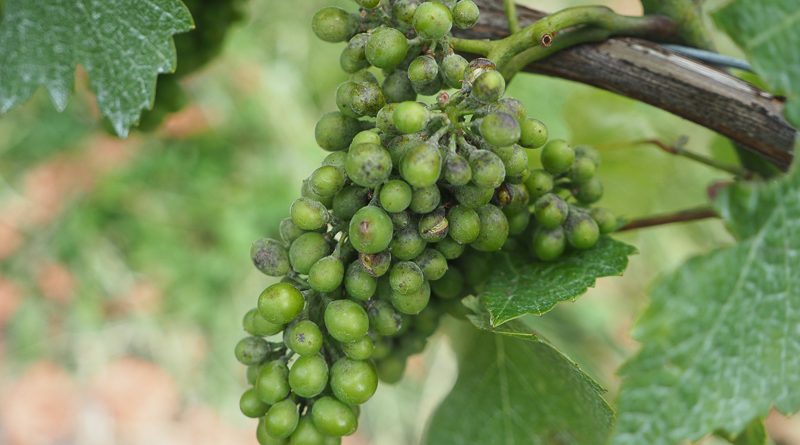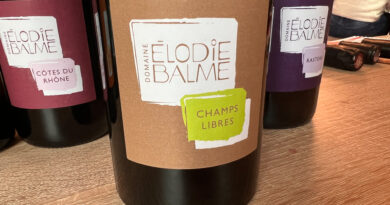Wine science: powdery mildew, the wine world’s biggest problem
Anyone who’s ever tried to grow grape vines without spraying them will probably have come across powdery mildew. It’s the biggest disease of grape vines, and is one of the key reasons wine growers have to spray chemicals several times a year. It’s found everywhere in the wine world, and all Vitis vinifera varieties are susceptible.
Erysiphe necator is the scientific name for grapevine powdery mildew. It was originally known as Oidium tuckeri, and some people still refer to it as oidium, especially in France. You might also see it referred to as Uncinula necator, but E. necator is the standard.
Some history. E. necator hails from the USA. There, native grape vines have had a very long time to co-evolve with this fungus, and develop resistance to it. But then, in 1845, it found its way to the hot house of an English gardener. Edward Tucker, in Margate, noticed it on his vine. He consulted with M. J. Berkeley, a Bristol-based botanist, who identified it as a new species and named it after Tucker. Tucker also had a look at it under a microscope, and decided that this was a very similar disease to peach mildew, which he was already familiar with. Back in 1821 an Irish gardener called John Robertson had successfully used sulfur to control peach mildew, so Tucker tried it too, and it worked. Robertson had mixed sulfur with soap, whereas Tucker mixed it with lime. Both approaches worked.
Despite the successful treatment, this powdery mildew had already started its spread, across the UK and to France. Before long, it was a major problem across the vineyards of Europe. It was first spotted in French vineyards in 1847, and then in Italy in 1849. In the early 1850s its ongoing transmission caused massive problems economically, as winegrowers learned to get to grips with the best ways of applying sulfur as a remedy.
Since then, it has been an ever present in the vineyards of the world.
E. necator is a fungal disease. There are two ways that it spreads. The first is by structures called conidia, which are asexual propagules dispersed by the wind. The fungus overwinters as a mycelium (a mass of fungal hyphae, which are like tubes, and are how it normally grows). Often, the mycelium will overwinter in a developing bud. When the vine starts growing, the bud opens and the whole of the structure that grows out will be infected by the fungus. This is called a flag shoot. After a while, all the green parts of this shoot are covered by what looks like a white powder: these are the conidia, and they infect the rest of the vine. The second mode of transmission is by the formation of structures called cleistothecia. These are the sexual stage of the fungus, and are particularly dangerous because when the fungus has sex, it jumbles its genes around, and resistance to any fungicide is much more likely to occur.
The cleistothecia are black spherical bodies and they contain 4-6 asci, each containing 4-7 ascospores. They typically overwinter in the bark of the vine, and then in the spring release the spores which germinate and restart the fungal disease. Cleistothecia aren’t present in all countries where powdery mildew is found (for example, they are a relatively recent discovery in New Zealand, where they previously hadn’t been found).
All the green parts of the vine are susceptible to powdery. The conidia or the ascospores germinate to produce tip-growing filaments called hyphae. Along their length, they produce structures called appressoria, which pierce the epidermal cells. Haustoria are then formed inside the plant’s epidermal cells that farm nutrients and enable the fungus to carry on growing. In turn, the fungus then develops new conidia or cleistothecia, and spreads itself further. When powdery affects the grape berries, it damages the epithelial layer. Thus while the berry continues to develop, the epithelium doesn’t and the berry splits.
Interestingly, while most people associate dampness with fungal diseases, humidity isn’t a vital factor in the spread of powdery mildew. It is what is known as a xerophytic plant pathogen: the conidia are adapted to germinate under dry conditions, and rain can actually reduce germination. But there’s a twist here. E. necator doesn’t like UV light, so damp, shady conditions can work in its favour.
This is one of the reasons that canopy management is a tool for mildew management. Opening up the canopy, and particularly the fruit zone, is protective, because sunlight reduces disease pressure. It also enables penetration of the leaf and fruit surfaces by fungicides, which is especially important when we’re talking about sulfur, which is a contact fungicide and needs to be applied evenly across all surfaces to be effective.
How can you deal with powdery? The main treatment is still sulfur, which is usually applied as a wettable formulation. It’s a contact fungicide, and needs to cover all the green areas of the vine, and be re-applied at regular intervals. Because it has several mechanisms of dealing with the fungus, resistance doesn’t develop. In some areas it needs to be applied weekly during the times of peak disease pressure, which in the southern hemisphere coincides with Christmas. There are also systemic fungicides, which are more targeted to specific mechanisms of action. For this reason, these need to be alternated depending on the mechanism of action, to avoid resistance developing. Most of these are preventive, but some also have eradicant action.
Interestingly, there is a new organic product with eradicant action, HML32. This is a potassium-based liquid soap, and when it is applied with a copper fungicide (such as Nordox) and potassium bicarbonate, it is quite effective at knocking back an existing powdery infection.
What about resistance? 12 different genes have been identified in American and Asian native grape species that confer resistance to powdery. Can these be bred into vinifera? Attempts are well underway, and there exist a number of hybrids that have a high percentage of vinifera genes but also good resistance to powdery mildew. Whether or not the wine world is ready for new varieties like this remains to be seen, but unless the world embraces transgenic (genetically modified) grapes varieties, then this is the only way that all this excessive spraying of vineyards can be avoided.




